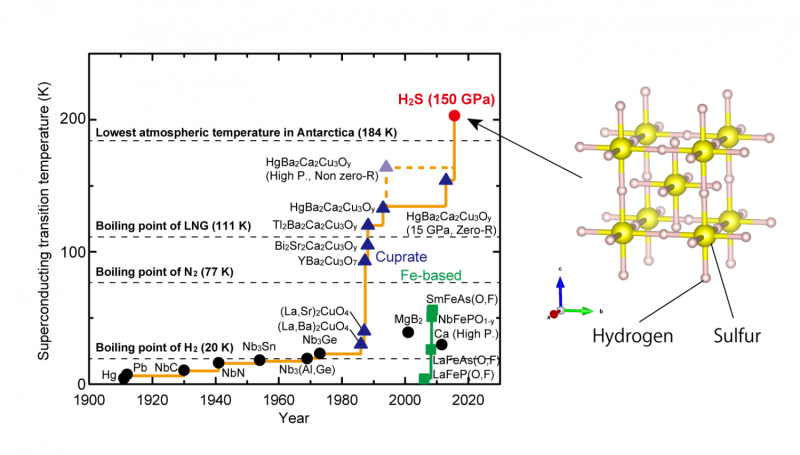Unraveling the crystal structure of a record high-temperature superconductor

For the first time, a research group led by Osaka University, Japan, clarified the crystal structure of hydrogen sulfide in its superconducting phase at the high temperature of -70°C. This was achieved by conducting a combination of experiments at one of the world's largest synchrotron radiation facilities, SPring-8 in Japan. These results mark a huge step toward developing room-temperature superconductors, which may provide promising solutions to energy problems.
Superconductivity is a phenomenon that occurs when the electrical resistance of materials reaches zero as they are cooled down to a certain temperature. While the possible applications for superconductors are manifold, such as using them as energy transmission lines without energy loss, widespread use is difficult as costs for cooling are high. Last year, hydrogen sulfide set a new record for highest superconducting transition temperature under high pressure. However, its crystal structure is not well understood, and therefore its superconductive mechanism also remains unclear. A research group led by Prof. Katsuya Shimizu and Dr. Mari Einaga at Osaka University, together with Dr. Mikhail Eremets at the Max Planck Institute for Chemistry, and Dr. Yasuo Ohishi at the Japan Synchrotron Radiation Research Institute, has now succeeded in clarifying this structure by simultaneously conducting measurements of high pressure electrical resistance and X-ray diffraction.
Since hydrogen sulfide consists of light elements, measurements required a special setup. Therefore, these measurements were conducted at the synchrotron radiation facility SPring-8, and consisted of using a diamond anvil cell to conduct measurement under high-pressure and low temperature, and the high-pressure beam line BL10XU with which high-intensity, high-energy and micro-diameter X-ray beams for X-ray diffraction can be used, in order to examine the material's crystal structure. The researchers clarified that under high pressure, H2S molecules underwent a structural change to H3S and that this H3S structure exhibited superconductivity. Furthermore, from simultaneously measuring changes in pressure of superconducting transition temperature, they discovered that H3S displayed two superconducting phases: one with a cubic structure, the other with a hexagonal structure. They thereby managed to prove previous predictions from theoretical calculations.
The results of this study will contribute to clarifying the mechanisms of the high-temperature superconductivity observed in hydrogen sulfide. They also mark a considerable step in developing room-temperature superconductors and provide new insights that will be useful in the development of new materials that spread under high pressure.
More information: Mari Einaga et al, Crystal structure of the superconducting phase of sulfur hydride, Nature Physics (2016). DOI: 10.1038/nphys3760
Journal information: Nature Physics
Provided by Osaka University




















